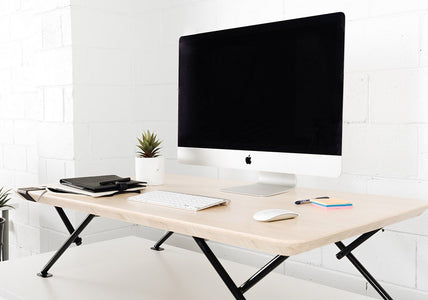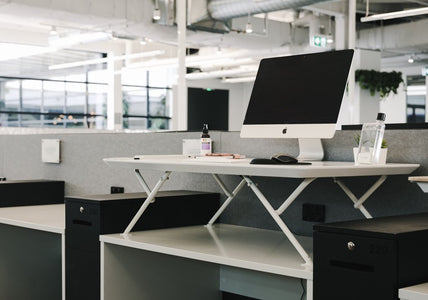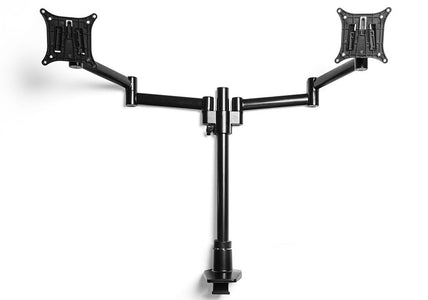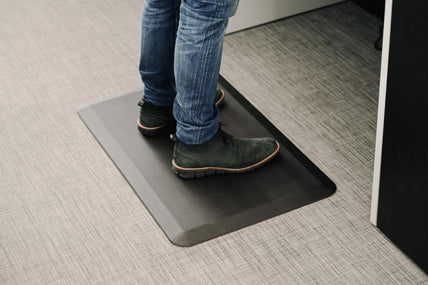Stand-Up Desk Ergonomics: Things To Do And To Avoid
By Daniel Angelini on August 17, 2021Many people already know about the benefits of standing desk setups, and a lot of workers already incorporate standing in their daily routines. Alternating between sitting and standing while you work prevents you from becoming sedentary, which keeps you healthy. However, improperly using these kinds of desks can bring other health issues. Here are several problems standing desk users encounter and possible solutions for them.
Your Screen Is Too Low
If you have neck and back pain, one of the reasons might be that your computer screen is too low. If you look down for long periods, especially while standing, you will strain the muscles in these areas. To prevent this from happening, raise your monitor and tilt it back, so you do not have to lean forward or angle your head down to see the screen. A laptop stand will also help. Putting your laptop on a stand will raise the bottom at least eight inches off the desk surface, allowing your neck to be at the correct angle for minimum strain.
Your Desk Is The Wrong Height
Desk ergonomics affects your keyboard and monitor positioning, which in turn affects your wrist, upper back, and neck comfort. Keep joint strain away by raising your desk to a 90 degree elbow height and ensure that your elbows stay close to your body. If your elbows pull away from your body to reach your keyboard or mouse, you know that your desk is higher than it should be.
You Stand On A Hard Surface
Hardwood, concrete, or tile floors can make standing tedious. Commercial-grade carpet is also a culprit; prolonged standing leads to discomfort and joint pain. If the cost of changing the floor surface is prohibitive, you can just put a standing mat in front of your desk. Standing mats can ease the pressure on the balls and heels of your feet, as well as helping to improve your posture.
You Bend Your Wrists Upward When Typing
Besides desk height, the way you rest your hands on a keyboard can affect your wrist health. If you spend a lot of time typing, you should be proactive about minimising wrist pain. Ensure that your wrists are as close as possible to 180 degrees of your forearms. If your wrists bend upwards when you work, even if your desk height is ideal, you can get a keyboard pad to help support.
You Don't Move Around When You're Standing
Often, people equate standing with standing still, and they stay in a fixed position while using their standing desk. You can move and change positions as often as you like when using a standing desk; add as much movement and variability as you can. Besides shifting your weight, you can alternate resting one leg on a footstool, walk around for several seconds, or bend your knees every so often.
Your Shoes Are Not Conducive To Standing
Many people prioritise aesthetics over comfort, especially when they are at a physical office. Often, people prioritise stylish over comfortable footwear, which is fine if they sit all day. However, if you have access to a standing desk, your footwear becomes more critical. When you want to have a standing desk setup, you need to consider your footwear. Besides investing in comfortable shoes, you can put insoles in your existing pairs to make them easier on the feet.
You Stand Longer Than Optimal
Some people are so eager to get into the habit of standing up while working that they attempt to stop sitting entirely. However, this is often an unrealistic goal. When you take too long to stand, especially if you are starting or have the wrong posture, you will only increase your risk for back or joint pain.
Start with five or ten minutes of standing instead of jumping in with intense regimens. Also, do not exceed more than four hours during a workday, and break those hours into increments. Alternating sitting and standing is the best way to go. Eventually, when you build your endurance, you can stand for several minutes at a time.
You Need To Improve Your Posture
Poor posture is a habit. If you lean into or hunch over your desk while working, it can feel comfortable for you when you do. However, this hurts your muscles and your joints in the long run.
Develop your posture by ensuring an ergonomic setup; your desk height, monitor, and keyboard position will have to be the same whenever you work. Though it might take a while for your body to "forget" poor posture, it is possible, especially if you are mindful about keeping your back straight and your head steady.
You can also develop your posture by doing deep breathing exercises. Also, poor posture restricts the diaphragm and prevents it from expanding the lungs to its full capacity. Not breathing to the fullest can cause a ripple effect of issues, affecting your well-being and compromising your health. When you do deep breathing exercises, you decrease stress and signal your parasympathetic nervous system to slow down.
You Need To Switch Your Chair
Even if you are used to standing while working, you will still need to sit at some point during the day. Sitting puts more strain on your lower back; you need to have a high-quality chair that ensures your comfort while you are seated. You don't want to wipe out the benefits standing brings!
When choosing a chair, get one with adjustable armrests, lumbar and thigh support, and a soft seat surface. Chairs that have these features are typically pricier, but they are worth the expense. These chairs often last longer and make standing less painful.
Conclusion
Incorporating more standing in your work routine will help you stay healthy. However, misusing a sit-stand desk can hurt instead of help you. Ensure that your setup is ergonomic and that your posture and breathing is good so you can get the most out of this kind of desk.
Shop at Movi for the best standing desk setup and accessories in Melbourne. Our award-winning desk has a fully electric control panel allowing you to easily adjust your workspace to your preferred height. Elevate your work experience today; contact us for enquiries!










